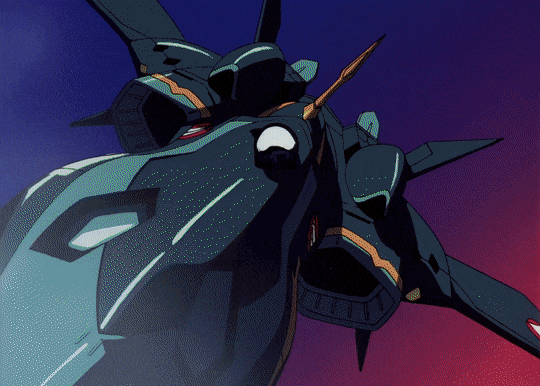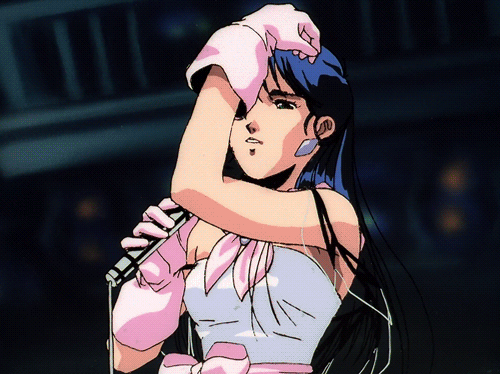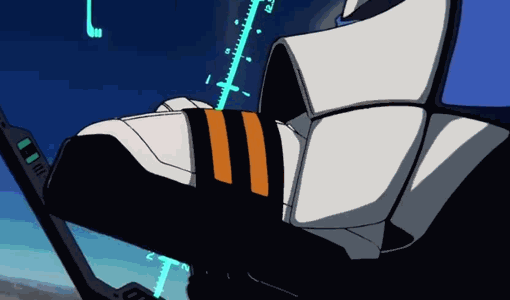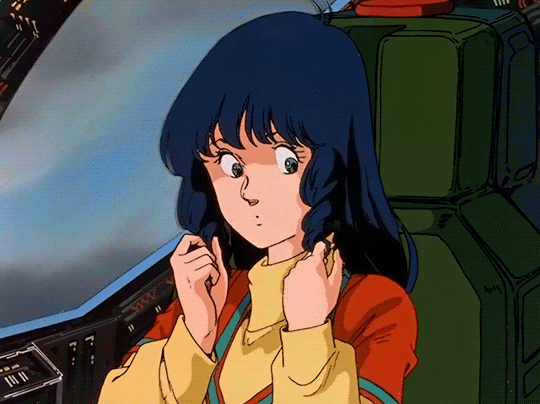originally posted at https://canmom.tumblr.com/post/658064...
Tonight’s Animation Night hits a power of 2… which means it’s surely an apt time for giant robots! I figured that it would be a good time to check out a series with a looming reputation which I’ve yet to sample… Super Dimension Fortress Macross.
Macross is one of your old guard long-running mecha series, dating back to 1982 - not quite so prolific as Gundam, but definitely one of the heavyweights from that era. The product of Studio Nue, a team already well-respected for their design work on early mecha shows like Yamato and Gundam, Macross struck out in an unusual direction by framing its plot around the cross-cultural emotional power of pop music.
But what made it really stand out, at least if you ask a sakuga fan, was Ichirō Itano.
Itano is a fascinating guy: he. In terms of our sakuga history, he’s one of those early ‘charisma animators’ to get a personal reputation, and he was indeed directly inspired by Kanada (whose work we saw a couple weeks ago). His hallmark, as Sean Bires describes in that video, was an ingenious understanding of 3D space - getting the camera right up into the action, crossing over between different scales with the kind of shot that only animation can do: the camera flying from a closeup of the pilot in the cockpit of a spaceship out to a long dramatic shot of a battle, using changes of lens angle etc. to push the intensity further.
And more specifically, he created one of anime’s most enduring motifs: the Itano Circus. You’ve probably seen this kind of shot homaged in dozens of different shows: something shoots out a huge swarm of missiles (or magic rays, tentacles, etc.), and they arc and twist all around the camera before closing in on their target. Famously, the story goes that Itano devised this trick by strapping a bunch of fireworks to his motorbike and igniting them - and the experience of of moving in the middle of the swarm of fireworks as they floated around him in every direction affected him so profoundly that he was determined to capture it in animation.
And he sounds like a real character, too:
I’m pretty sure Ichiro Itano is going to punch me in the face.
It’s hard to tell, because I have a pair of opera glasses strapped to my head, the wrong way round, so that everything looks as if I am staring at it down the wrong end of a telescope. But in the round window of my vision, I very clearly see the director of Gantz, his hair tied back in a ponytail, his wiry muscles rippling under a khaki vest, hauling back his arm and then lurching right at me.
His fist speeds into view, looming huge in the frame. His arm seems to trail behind it for an impossible distance, while his hand blocks the entirety of my view. I stumble backwards, expecting a blow at any moment, but Itano has deliberately fallen a couple of inches short.
“Ha!” he says. “See? That’s what the world looks like if you’re the pilot of a giant robot! You’re looking through a viewscreen, you see. You’re not using your real eyes, you’re using a camera! And so, when we show a pilot’s-eye view in an anime show, we shoot it the way that a camera would see it!”
Although this story is told often, the inspiration to do such a thing isn’t mentioned - but apparently it was driven by a scene in Android Kikaider where a guy shoots a rocket from a motorbike. Funny coincidence with this week’s toku tuesday…

By the time of Macross, Itano had honed his particular style on classic Sunrise shows like the original Gundam and especially Space Runaway Ideon. Let me spare a few words about Ideon, incidentally - although somewhat overshadowed by Gundam, to its fans, Ideon is adored for its especially nihilistic tone: Gundam creator Yoshiyuki Tomino’s disgust with war manifesting in a series of abrupt and brutal deaths of every beloved character.
Sadly, it’s one I can’t really figure out how to cram into Animation Night: the compilation film is said to cut so much as to be markedly inferior to the series, there is a span of about 20 episodes that never made it into a film, and without the effort to get attached to the characters, the final film doesn’t feel like it would deliver in the same way.

Like who’s this girl? I bet if I knew, I’d be like oh god no…
Anyway, as far as ppl like Itano were concerned, Ideon was his opportunity to hone the ethos developed in Gundam into something more concrete, and redefine how mecha battles would be framed in film. But his project really reached fruition in Macross.
So what’s this all in service of? The narrative of Macross concerns an invasion by aliens called the Zentradi, an engineered warrior species who, unmoored from their creators, mindlessly conquer without any meaningful culture. Humanity only stands a chance thanks to one of the first idols in anime, Linn Minmay, whose music throws the Zentradi into confusion and leads some of them to defect. This leads to a whole sprawling series of robot battles, love triangles, and extensive discussion of soft power.
Or at least, so I’m advised by youtube user Zeria, who provides one of the few attempts I’ve encountered to break it down on a thematic level. In their words, its thesis could be taken as:
Hard power is necessary, vital, and ultimately moral, but it’s soft power that will always win the day, and as a result, it’s imperative that a benevolent state wields both.
So where does this fit in, historically? We’ve talked before about the massive societal transformations taking place in 80s Japan when we watched Akira. We could maybe say that in such conditions, in which the nation-entity called “Japan” was suddenly becoming one of the economically powerful players within the American cold war bloc, was facing a question of how it should use that power. And we could tie that into subsequent developments - indeed, while no aliens ignorant of music have shown up, the seemingly eternal right-wing government has attempted to direct soft power in its interests with policies like “Cool Japan”.

Zeria argues that, while the cut corners of the original TV production undermine its ability to push this theme, the first summary movie Do You Remember Love does an exceptional job of pushing its ‘yay soft power’ theme on a formal level:
…this move successfuly demonstrates in full the power of the culture it comes from. Every frame of this movie bombards the viewer with peak 80s Japanese aesthetics, begging them to agree that the economic rise of the nation is a good thing. (…)
That said, the film’s quality is only able to emerge from a unique point in time, a period when it was far easier for those in Japan to have faith that culture would inevitably win the day. It was a time where the widespread anxiety that Japan would ultimately overtake the West still had purchase in the minds of ordinary people, leading to the rise of cyberpunk. For a culture like that, the use of military might as a protective deterrent, with culture being the real showshopper, was not a strange idea.
I feel like the interplay between cultural productions like this and nationalist projects is not something I address really often enough on Animation Night posts (usually because I don’t start these soon enough to really get into that thorny subject). I certainly don’t think most anime producers are particularly strong nationalists, and many of them may be fiercely critical of Japan, the industry, capitalist system etc. … but the existence of even subversive artworks attaches itself to the big ball of psychic imaginary force that is “a nation exists and is ‘like this’”, playing out in all sorts of ways in the behaviour of humans. For the kind of artist who hates her country and wishes to see it destroyed, how do you even sidestep that?

Well, I don’t know how to answer that, and in any case if I can trust Zeria, the creators of Macross had largely the opposite aim in mind. Fuckers. Let’s return to the robots… The robots of Macross are an early real-robot iteration on the ‘transforming robot’ concept: ‘variable fighters’ which can alternate between humanoid and fighter jet forms.
Though I linked this article by Sean O’Mara on the series’s robot design earlier, let’s talk more about it. The big names for Macross’s distinctive design language is Shoji Kawamori, who was there when the original Gundam developed the ‘real robot’ idea of mecha as simply being military equipment rather than mechanical superheroes. Kawamori, while competing with fellow Nue member Kazukaka Miyatake to design robots for a show called Genocidus (o.O steady on there), got the idea for a robot with “backwards” digitigrade legs after observing skiiers on a slope.
The concepts for Macross - a giant transforming space fortress, carrying a lot of smaller transforming space fighters inside it, slowly developed over other cancelled projects such as Battle City Megaroad. Part of the friction with the original Genocidus concepts was the difficulty of producing toys (the toy company apparently saying ‘make a humanoid robot, even if it just stands there), but it was also toy design that led to the return to this concept in Macross: it was easier to build a plane with drop down legs than a fully jointed figure.
One of Macross’ mechanical strengths was its variety, the result of the two talented designers working on it. While Kawamori focused on the svelte and aerodynamic VF-1, Miyatake created a range of designs from the chunky, non-transformable destroids that served as cannon fodder, to the show’s numerous spaceships.

Well, both the Super Dimension Fortress and Do You Remember Love proved major successes, and Macross was set to follow Gundam become a lasting giant robot franchise with multiple iterations slotting into a grander meta-series. The series was re-edited and dubbed for Americans under the title Robotech in 1985, alongside two other mecha anime, Super Dimension Cavalry Southern Cross and Genesis Climber MOSPEADA. But that’s all I’m going to say about that.
The next Macross entry, Flash Back 2012, is generally not so well remembered: an early OVA that relied heavily on recut footage and had a relatively thin narrative - though O’Mara makes a case for it. Another OVA sequel, Lovers Again, was made without the involvement of the original creators at Studio Nue, and would later be quietly dropped from continuity. It’s not until the 1990s that we get the next major entry into the series, the four episode OVA Macross Plus, which would then get recut into a movie with some extra reanimated footage.

If the original Macross was rooted in the capitalist optimism of the 80s, Plus has to adapt to the collapse of the bubble and the ‘lost decade’ of the 90s. How does it do that? …uh well, I don’t actually have a handy video essay to tell me what to think on this one.
Hmm. Casting around. Hey, here’s someone’s thesis. …OK, they go through this entire writeup without talking about prior Macross films, rather mostly drawing contrast with Akira and GitS, so I don’t know how far I can use this. (Reminds me that I still need to do some kind of writing poking into all the different flavour of GitS adaptation…) Also they totally missed what makes Tetsuo so great. Nevertheless, the major point raised by this article, which does seem to contrast to what we just claimed about SDF and DYRL, is an image of “statelessness” that’s created by… giving it a mostly American setting. I’m not convinced on that basis.
But it does connect us to the new director who appears at this point in Macross’s history… Shinichirō Watanabe, who would a few years later gain massive fame outside of Japan with works like Cowboy Bebop and Samurai Champloo - someone for whom heavy use of western and especially American cultural signifiers is, like, his entire main thing. So perhaps they’re onto something after all. How does this fit into a whole dialogue on states and soft/hard power proposed by Zeria? I don’t think I have enough information to say.

Instead, let’s talk about the premise. Macross Plus is set on a colony planet called Eden, focusing on a contest between two rival test pilots who find their future in the next generation of ‘variable fighters’ is threatened by a new AI-controlled fighter design. Only, that makes it vulnerable to, well, what if your AI super-idol goes evil and steals your slick new jet fighter? On a metaphorical level, I think I can imagine where we’re going with this.
The way @mogsk introduced me to this one, it sounds like Itano managed to outdo himself yet again on the animation department… I seriously cannot wait for the sakuga feast we have in mind. On that front, Macross Plus is the source of another incredible Itano anecdote:
“Let me put it like this,” he says. “There’s this flight school in America run by retired air force pilots. They’ll give you one lesson in really fast English, and one safety demonstration, and then they’ll take you up to 10,000 metres. You have a co-pilot, but he leaves it to you once you’re up. So it was me and Shoji Kawamori, in jets, ready for a dogfight. All as part of the research for Macross Plus. I wanted to know what it was like to fly a plane, to be in aerial combat, and I was curious about G-force.
“Each plane had a laser pointer, and if you could keep the enemy in your sights for three seconds, you scored a hit. So we started the dogfight, chasing our tails. I scored six hits on Kawamori. He was all over the place, but I was really good!
“So after all that, I decided: ‘I’ve done the dogfight. Let’s faint.’ So I grabbed the joystick and pulled right back on it. I heard the pilot shouting ‘Itano! Itano-san! Mr Itano! NO! Stop!’ and the G-force pushed me back in the seat. I felt my head lolling and then there was black. I’d blacked out, and it was like someone had pulled the plug on a computer.
Upon landing, he was taken aside and told to draw storyboards for a blackout scene.

Plus would soon be followed by a long-running TV series Macross 7, with its own films; then as we hit the 2000s we get a whole cornucopia of prequels, interquels, videogame spinoffs et cetera to celebrate various anniversaries. I have no ability to tell you which ones are notable or good - should we find ourselves enjoying Macross, perhaps we could pick out a few somewhere down the line.
As for Itano, Gen Urobuchi apparently relates that after a motorbike accident that injured his hand, Itano was no longer able to paint (I presume they mean draw keyframes?), and turned his efforts to directing and training new animators instead. In this role, he directed a number of very gory OVA projects like Battle Royal High School (the source of one of my favourite clips, I must watch the whole thing some time), and adapted Go Nagai in Violence Jack: Evil Town and the first anime take on Gantz - I can’t say if it’s a great adaptation, but the manga, for all its flaws and questionable narrative decisions, does hold a certain place in my heart as one of the first really edgy gory mangas I read.
Perhaps another one of these nights we can check out Itano-the-director. What I hear about these projects is that they’re extremely uneven: often cutting corners with photography in many cuts, but with a few really unique and groundbreaking scenes every now and then.
Unfortunately, Itano also takes the blame for directing and and co-writing Angel Cop, a late 80s-early 90s series about an extrajudicial police unit fighting communists which somehow abruptly swerves into cartoonishly nonsensical antisemitic conspiracy theory. I have no way to explain that; the best that can be said is that it was a complete turkey, with Itano’s name being the only reason it is remembered at all.

Macross is definitely one of the big holes in my knowledge of classic 80s anime, and from the sound of it, it’s going to be a great time and maybe provoke some kind of interesting discussions. Or maybe we’ll just meme, you never know. In any case, tonight, my plan is to show the Do You Remember Love film, and then the ‘movie edition’ of Plus. I may also try to find some clips from Ideon that show Itano’s development. Animation Night 64 is starting at 7pm UK time at twitch.tv/canmom - see you there!
Comments